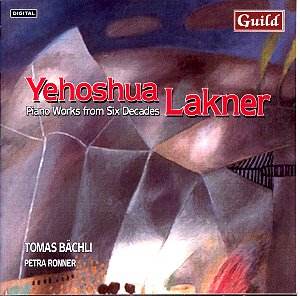 |
|
To be perfectly frank I had never heard either Lakner's name or music before reviewing this disc. Yehoshua Lakner was born in 1924 in Bratislava. At the age of 17 he emigrated to Israel (Palestine as it was then) where he resumed his musical education and studied with Alexander Boskovich and Ödon Partos at the Tel Aviv Academy of Music and later with Frank Pelleg in Haifa and Jerusalem. In 1950 Lakner joined the staff of the Tel Aviv Academy. In 1952, he travelled to the States and studied with Aaron Copland at Tanglewood. In 1959 and 1960 two grants enabled him to work in the studio for electronic music at West German Radio in Cologne with Stockhausen, Gottfried Michael Koenig and Mauricio Kagel. When in Germany he also studied with the late Bernd Alois Zimmermann. In 1963 Lakner moved to Zürich and started composing music for productions by Maria von Ostfelden as well as incidental music for various stage productions. During this period he composed a good deal of electro-acoustic music. His interest in the medium intensified and he embarked on a series of Audio-Visuelle Zerit Gestalten combining music and computer graphics. His varied output also includes several chamber and orchestral works.
The present release usefully covers Lakner's piano music from 1946 to 1992 and thus provides for a thorough insight into his multi-faceted approach of the medium. The earlier pieces here, Cornerstones dates back to 1946 and is a set of 19 easy polyphonic studies in which Bartok's example (e.g. For Children and Mikrokosmos) is clearly evident, as it is in the Three Short Piano Pieces of 1947. In the somewhat later Fünf Geburtstage ("Five Anniversaries") of 1965 the model is rather that of middle Schoenberg.
The more recent pieces signal a deliberate evolution towards greater freedom. Fermaten ("Fermatas") from 1977 is, so we are told, strictly notated but gives the player the opportunity to influence the way the piece sounds.
Kreise und Signale ("Circles and Signals") for two pianos goes considerably further in that direction. The piece has a variable form which allows still more freedom in the players' approach as is obvious from the two versions heard here. Differences may lie either in a different order of the work's sections or in dynamics.
The last piece in this collection, Alef Beth Gimmel completed in 1992 is based on three chords called Alef, Beth and Gimmel (i.e. the first three characters of the Hebrew alphabet) given at the outset and "spelled out" according to their speech rhythm. The piece consists of fixed and open sections, the latter allowing for some freedom on the player's part.
Lakner's piano music has a remarkable stylistic unity and all the pieces here are obviously from the same pen. The only significant difference is the composer's approach to form. This is much freer in the more recent pieces, although the aleatory features are strictly kept under control. No question here of formless random "do-as-you-please" writing.
Tomas Bächli has a close connection with Lakner's music (he has regularly performed the composer's piano music) and is thus fully in tune with Lakner's style and vision. Petra Ronner is a convincing partner in the exacting, though highly rewarding Kreise und Signale.
Well worth investigating.
Hubert Culot